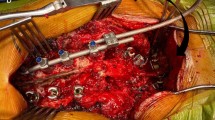Abstract
Purpose
To compare the radiological outcomes and complications of adult spinal deformity patients who underwent a pedicle subtraction osteotomy (PSO) below L2 but categorized according to their construct where either a domino connector was applied for osteotomy correction or not.
Methods
Retrospective review of a prospective, multicenter adult spinal deformity database (5 sites). Inclusion criteria were adult patients who underwent PSO between L3 and L5 with a minimum follow-up of 2 years. Among 1243 patients in the database, 79 met the inclusion criteria, 41 in the no-domino (ND) group and 38 in the domino (D) group. The domino technique consisted of using 2 parallel rods connected by a domino on one side of the PSO in order to achieve gradual and controlled compression at the osteotomy site. Demographic data, operative parameters, spinopelvic parameters and complications were collected.
Results
Demographic data and operative parameters were globally similar between both groups, and they showed a comparable preoperative sagittal malalignment. Segmental lordosis improved by 22° and 31° (p < 0.05) and L1S1 lordosis improved by 23° and 32° (p < 0.05) in the ND and D group, respectively. The use of multiple rods was similar between the groups (58% vs. 57%). Also, mechanical complications rate was globally similar between both groups with no statistically significant difference (22% vs. 28.9%).
Conclusion
Domino connector is a safe, powerful and efficient tool for pedicle subtraction osteotomy site closure. It improved the lumbar lordosis correction angle with an acceptable rate of complications.



Similar content being viewed by others
References
Girod PP, Kogl N, Molliqaj G, Lener S, Hartmann S, Thome C (2021) Flexing a standard hinge-powered operating table for lumbosacral three-column osteotomy (3-CO) site closure in 84 consecutive patients. Neurosurg Rev. https://doi.org/10.1007/s10143-021-01559-5
Jones KE, Hunt MA, Martin CT, Polly DW (2019) Controlled pedicle subtraction osteotomy site closure using flexible hinge-powered operating table. Oper Neurosurg (Hagerstown) 17:E214–E218. https://doi.org/10.1093/ons/opy397
Gupta S, Gupta MC (2018) The nuances of pedicle subtraction osteotomies. Neurosurg Clin N Am 29:355–363. https://doi.org/10.1016/j.nec.2018.03.001
Faundez A, Le Huec JC, Hansen LV, Poh Ling F, Gehrchen M (2019) Optimizing pedicle subtraction osteotomy techniques: a new reduction plier to increase technical safety and angular reduction efficiency. Oper Neurosurg (Hagerstown) 16:383–388. https://doi.org/10.1093/ons/opy086
Obeid I, Bourghli A, Boissiere L, Vital JM, Barrey C (2014) Complex osteotomies vertebral column resection and decancellation. Eur J Orthop Surg Traumatol 24(Suppl 1):S49-57. https://doi.org/10.1007/s00590-014-1472-6
Bourghli A, Boissiere L, Konbaz F, Al Eissa S, Al-Habib A, Qian BP, Qiu Y, Hayashi K, Pizones J, Ames C, Vital JM, Obeid I (2021) On the pedicle subtraction osteotomy technique and its modifications during the past two decades: a complementary classification to the Schwab’s spinal osteotomy classification. Spine Deform 9:515–528. https://doi.org/10.1007/s43390-020-00247-6
Watanabe K, Lenke LG, Daubs MD, Kim YW, Kim YB, Watanabe K, Stobbs G (2008) A central hook-rod construct for osteotomy closure: a technical note. Spine 33(10):1149–1155. https://doi.org/10.1097/BRS.0b013e31816f5f23
Hyun SJ, Lenke LG, Kim YC, Koester LA, Blanke KM (2015) Long-term radiographic outcomes of a central hook-rod construct for osteotomy closure: minimum 5-year follow-up. Spine 40(7):E428–E432. https://doi.org/10.1097/BRS.0000000000000783
Berjano P, Cucciati L, Damilano M, Pejrona M, Lamartina C (2013) A novel technique for sublaminar-band-assisted closure of pedicle subtraction osteotomy. Eur Spine J 22:2910–2914. https://doi.org/10.1007/s00586-013-3113-x
Patel R, Khan SN, McMains MC, Gupta M (2015) Technique for lumbar pedicle subtraction osteotomy for sagittal plane deformity in revision. Am J Orthop (Belle Mead NJ) 44:261–264
Chiffolot X, Lemaire JP, Bogorin I, Steib JP (2006) Pedicle closing-wedge osteotomy for the treatment of fixed sagittal imbalance. Rev Chir Orthop Reparatrice Appar Mot 92:257–265. https://doi.org/10.1016/s0035-1040(06)75733-6
Barton C, Noshchenko A, Patel V, Cain C, Kleck C, Burger E (2015) Risk factors for rod fracture after posterior correction of adult spinal deformity with osteotomy: a retrospective case-series. Scoliosis 10:30. https://doi.org/10.1186/s13013-015-0056-5
Author information
Authors and Affiliations
Consortia
Corresponding author
Ethics declarations
Conflict of interest
The authors declare that they have no conflict of interest.
Additional information
Publisher's Note
Springer Nature remains neutral with regard to jurisdictional claims in published maps and institutional affiliations.
Rights and permissions
About this article
Cite this article
Bourghli, A., Boissiere, L., Cawley, D. et al. Domino connector is an efficient tool to improve lumbar lordosis correction angle after pedicle subtraction osteotomy for adult spinal deformity. Eur Spine J 31, 2408–2414 (2022). https://doi.org/10.1007/s00586-022-07322-8
Received:
Revised:
Accepted:
Published:
Issue Date:
DOI: https://doi.org/10.1007/s00586-022-07322-8




